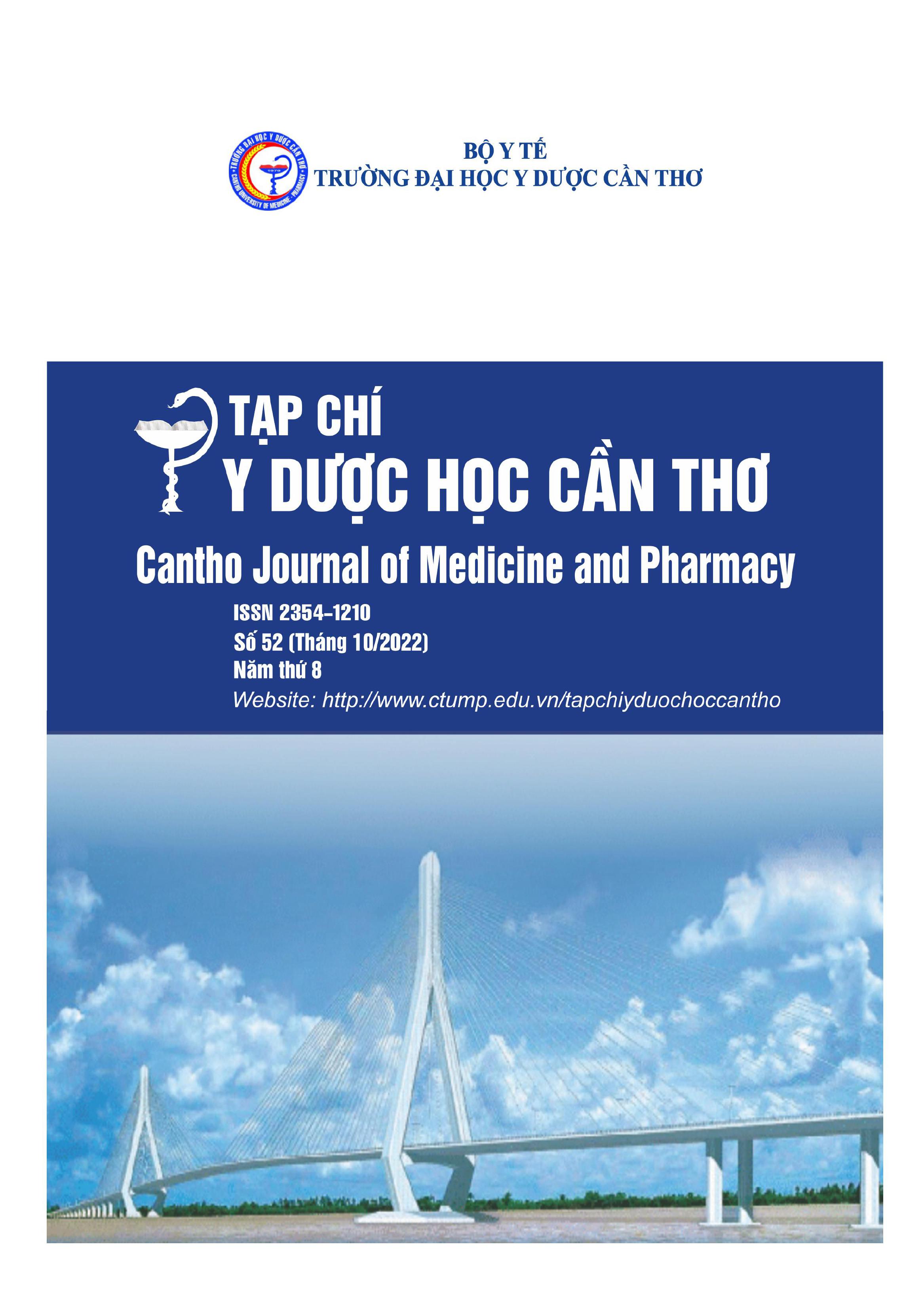EVALUATED THE SHORT-TERM OUTCOMES OF USING LONGO PROCEDURE IN THE TREATMENT OF HEMORRHOIDS AT CAN THO UNIVERSITY OF MEDICINE AND PHARMACY HOSPITAL AND CAN THO CENTRAL GENERAL HOSPITAL
Main Article Content
Abstract
Background: Stapled hemorrhoidectomy is a surgical procedure used worldwide for the treatment of hemorrhoids in all age groups. Stapled hemorrhoidopexy has a few advantages such as less postoperative pain and faster recovery compared with conventional hemorrhoidectomy. Objectives: Evaluated the short-term outcomes of using Longo procedure in the treatment of hemorrhoids at Can Tho University of Medicine and Pharmacy Hospital and Can Tho Central General Hospital. Materials and Methods: A prospective study of 55 patients underwent Longo procedure from May 2021 to May 2022. They were evaluated on the basis of the following main parameters: postoperative pain, bleeding, operating time, days of hospitalization, time taken to return to work. Results: The male/female ratio was 2.06 (37 males, 18 females). The average age was 44.9 ± 14.7 years old. Mean duration of illness was 4.65 ± 2.8 years old. Majority of patients suffered from 3th degree hemorrhoids (98.2%). Long sitting was the most relevant factor (69.1%). The operating time was 27.3 ± 6.4 minutes. The mean duration of hospital stay was 1.7 ± 0.91 days and returned to work was 6.3 ± 2.7 days. 61.8% of patients had only mild pain. All patients had no postoperative hematochezia. 23.7% of patients had urinary retention. One patient had the complication of anorectal stricture. 100% of patients had normal anal continence. The level of satisfaction was high in 98.2% of patients. Conclusions: The Longo´s technique for the treatment of hemorrhoids has the potential for less postoperative pain, enhanced patients’ comfort, a short operating time, safety and an early return to full activity.
Article Details
Keywords
Longo procedure, hemorrhoids, safety
References
2. Hoàng Lê Minh (2015), Kết quả điều trị bệnh trĩ bằng phẫu thuật Longo tại Bệnh viện Trường Đại học Y khoa Thái Nguyên, Luận văn thạc sĩ, Đại học Y khoa Thái Nguyên.
3. Trịnh Hồng Sơn, và cộng sự (2007), “Phẫu thuật Longo trong điều trị trĩ tắc mạch”, Tạp chí y học thực hành, (số 2), tr.58-60.
4. Huỳnh Bảo Tâm (2015), Nghiên cứu đặc điểm lâm sàng và đánh giá kết quả sớm điều trị bệnh trĩ bằng phẫu thuật Longo tại Bệnh viện Trường Đại học Y Dược Cần Thơ và Bệnh viện Đa khoa Trung ương Cần Thơ, Luận án chuyên khoa cấp II, Đại học Y dược Cần Thơ.
5. Nguyễn Minh Tâm (2016), Nghiên cứu đặc điểm lâm sàng, phân độ và đánh giá kết quả của khâu treo triệt mạch điều trị bệnh trĩ tại Bệnh viện Đại học Y Dược Cần Thơ, Luận án chuyên khoa cấp II, Đại học Y Dược Cần Thơ.
6. Phan Minh Trí, Đỗ Đình Công (2021), “Bệnh trĩ”, Bệnh học Ngoại khoa Tiêu hóa, Nhà xuất bản Y học, TP. Hồ Chí Minh, tr. 421-437.
7. Angus J M Watson, Jemma Hudson, Jessica Wood, et al (2016), “Comparison of stapled haemorrhoidopexy with traditional excisional surgery for haemorrhoidal disease (eTHoS): a pragmatic, multicentre, randomised controlled trial”, The Lancet, 388, pp.2375–2385.
8. Riss S, Weiser FA, Schwameis K, et al (2012), “The prevalence of hemorrhoids in adults”, Int J Colorectal Dis, 27, pp.215–220.
9. Sun Z, Migaly J. (2016), “Review of Hemorrhoid Disease: Presentation and Management”, Clin Colon Rectal Surg, 29(1), pp.22-99.
10. Tanveer Abbas, Mubashar Ahmed Bajwa Rasikh Maqsood, Muhammad Talha Akhtar (2019), “Is stapled hemorrhoidectomy a safe procedure for third and fourth grade hemorrhoids”, Pak Armed Forces Med J, 69 (1), pp.92-96.
11. Thwayeb Y (2004), “Randomized Clinical Trial of Longo´s Technique Versus Ferguson’s Haemorrhoidectomy; Follow-up Three Years”, Eastern Journal of Medicine, 9(1),pp.34-38.
12. Tzu-Hsuan Wang (2020), “Comparison of the short-term outcomes of using DSt and ppH staplers in the treatment of grade III and IV hemorrhoids”, Scientific reports,10, pp.5189.
13. Watts J. M., Bennett R.C., Duthie H.C., et al. (1964), “Healing and pain after haemorrhoidectomy”, Br J Surg, 51 (11), pp.808-817.


